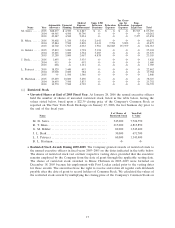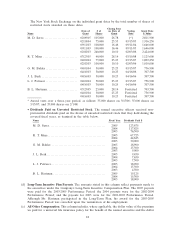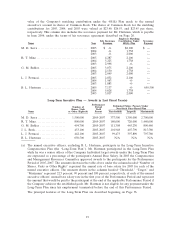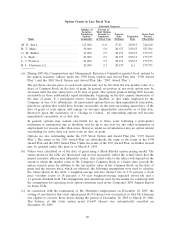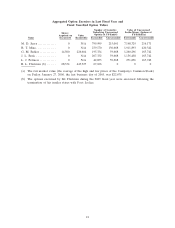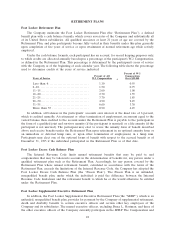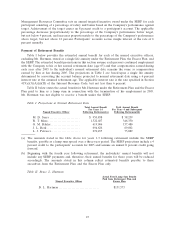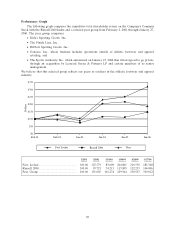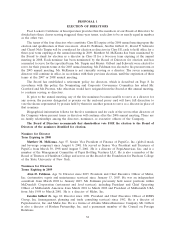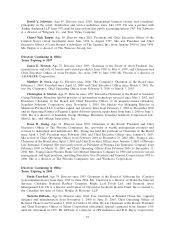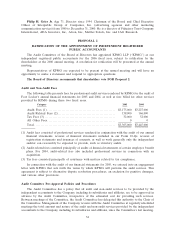Foot Locker 2005 Annual Report Download - page 119
Download and view the complete annual report
Please find page 119 of the 2005 Foot Locker annual report below. You can navigate through the pages in the report by either clicking on the pages listed below, or by using the keyword search tool below to find specific information within the annual report.Trust Agreement
The Company has established a trust (the “Trust’’) in connection with certain of its benefit plans,
arrangements, and agreements, including certain of those described above, and other benefit plans,
agreements or arrangements that subsequently may be covered (collectively, the “Benefit Obligations’’).
Under the Trust agreement, in the event of a Change in Control of the Company (as defined in the
Trust agreement), the trustee would pay to the persons entitled to the Benefit Obligations, out of funds
held in the Trust, the amounts to which they may become entitled under the Benefit Obligations. Upon
the occurrence of a Potential Change in Control of the Company (as defined in the Trust agreement),
the Company is required to fund the Trust with an amount sufficient to pay the total amount of the
Benefit Obligations. Following the occurrence, and during the pendency, of a Potential Change in
Control, the trustee is required to make payments of Benefit Obligations to the extent these payments
are not made by the Company.
Compensation Committee Interlocks and Insider Participation
During 2005 the following individuals (none of whom had been an officer or employee of the
Company or any of its subsidiaries) served on the Compensation and Management Resources
Committee: Purdy Crawford, Philip H. Geier Jr., James E. Preston, Christopher Sinclair and Cheryl
Nido Turpin. There were no interlocks with other companies within the meaning of the SEC’s proxy
rules. As noted on Page 9, Mr. Crawford is Counsel to the Canadian law firm of Osler, Hoskin &
Harcourt LLP, which provides legal services to the Company. Mr. Crawford does not participate in
decisions regarding awards to executives covered by Section 16(a) of the Securities Exchange Act of
1934 under the Company’s 1998 Award Plan, the 2003 Award Plan or, prior to its expiration, the 1995
Award Plan.
Report of the Compensation and Management Resources Committee on Executive Compensation
The Compensation and Management Resources Committee of the Board of Directors, composed
of the independent directors named below, has responsibility for all compensation matters involving the
Company’s executive officers, and for significant elements of the compensation of the chief executive
officers of its business units.
Compensation Policy
The Company’s executive compensation program is designed to attract, motivate, and retain
talented retail industry executives in order to maintain and enhance the performance of the Company
and its return to shareholders. The Committee believes that executive compensation should be balanced
between annual and long-term compensation and that a substantial portion of the compensation of the
Company’s executive officers, whether paid out currently or on a long-term basis, should be dependent
on the Company’s performance. It is the Committee’s view that more senior officers should have a
greater portion of their compensation at risk, whether through incentive programs based upon the
achievement of performance targets or through stock price appreciation. The principal components of
the executive compensation program are as follows:
I. Annual Compensation
Base Salary. Base salaries for executive officers are determined based on a number of factors,
including the responsibilities of the position, the performance of the executive, and base salaries for
comparable positions at companies in the retail and athletic footwear and apparel industries.
Annual Bonus. Executive officers participate in the annual bonus program, which provides for
payment of a percentage multiple of the executive’s base salary depending upon the Company’s
performance in relation to targets established by the Committee at the beginning of each plan year. In
recent years, including 2005, these targets have been a combination of pre-tax income and return-on-
invested-capital. These performance targets are based on the business plan and budget for the year
reviewed and approved by the Finance and Strategic Planning Committee and the Board of Directors.
27


